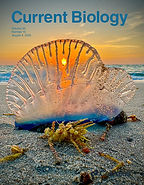Publications
*corresponding author **mentee
15.
Aoki R, Nishihara H, Sakamoto T, Sato Y, Kuramoto T, Fukuda M, Matsunaga T, Uehara A, Slane D, Kawanishi Y, Mori S, Nagaoka D, Hirakawa M, Gao H, Maijima D, Suto Y, Ishii K, Anthony CJ, Ishiyama S, Kato S, Inui Y, Wada N, Mogi Y, Yoshida Y, Matsuzaki M, Suzuki T, Kuroiwa T, Ohkawa Y, Ikawa T, Lister R, Maruyama S, Kimura S, Matsunaga S. Algal-mammalian cell fusion facilitates chromosome transfer through genomic hitchhiking. In review.
14.
Lock C*, Miller T, Anthony CJ, Rouzé H, Fifer J, McDermott G, Tramonte CA, Davies SW, Raymundo LJ, Bentlage B. Symbiodiniaceae and bacterial microbioime dynamics differentially impact the survival of dominant reef-flat Porites corals. Environmental Microbiology. 27, e70175. https://doi.org/10.1111/1462-2920.70175
13.
Wagner MA*, Wang Z, Anthony CJ, Rivera EA, Strader ME. (2025). iNaturalist data suggests a recent northward expansion of the upside-down jellyfish, Cassiopea. Science of the Total Environment. 992, 179948. https://doi.org/10.1016/j.scitotenv.2025.179948
12.
Church S*, Abedon RB, Ahuja N, Anthony CJ, Destanović D, Ramirez DA, Rojas LM, Albinsson ME, Álvarez Trasobares I, Bergemann RE, Bogdanovic O, Burdick DR, Cunha TJ, Damian-Serrano A, D'Elifa G, Dion KB, Doyle TK, Gonçalves JM, Gonzalez Rajal A, Helm RR, Le Gouvello D, Lewis ZR, Magalhães BIMM, Mańko MK, Mayorga Adame CG, de Mendoza A, Moura CJ, Munro C, Nel R, Oguchi K, Perelman JN, Prieto L, Pitt KA, Roughan M, Schaeffer A, Schmidt AL, Sallanes J, Wilson NG, Yamamoto G, Lazo-Wasem EA, Simon C, Decker MB, Coughlan JM, Dunn CW. (2025). Global genomics of man-o'-war (Physalia) reveals ocean surface biodiversity. Current Biology. https://doi.org/10.1016/j.cub.2025.05.066
11.
Anthony CJ*, Lemer S, Raymundo LJ, Rouzé HL*. (2025). Restoration innovation: Fusing microbial memories to engineer coral resilience. One Earth. 8, 101193. https://doi.org/10.1016/j.oneear.2025.101193
In brief. We propose a scalable technique to build flexibility into individual colonies by fusing clonal corals that have been acclimated to, or raised in, different environments by utilizing the rapid growth, increased survival, and diversified toolkit associated with coral fragmentation, fusion, and microbiomes. This is the first attempt to conceptually integrate coral microbiology, restoration, and fusion into a single technique capable of maximizing coral resilience and restoration scalability.
10.
Anthony CJ*, Lock C, Pérez-Rosales G, Rouzé HL, Paulino Jr. L**, Raymundo LJ, Bentlage B. (2024). Symbiodiniaceae phenotypic traits as bioindicators of acclimatization after coral transplantation. Marine Pollution Bulletin. 209, 117250. https://doi.org/10.1016/j.marpolbul.2024.117250
In brief. This was a foundational attempt to develop phenotypic traits of photo-endosymbionts as coral stress bioindicators. Using a personally developed flow cytometry protocol [1.3] we discovered two things. 1) Symbiodiniaceae cells increase in roughness after transplantation. 2) Coral paling does not necessarily reflect the Symbiodiniaceae assemblage.
9.
Salas R**, Anthony CJ*, Bentlage B. (2024). Light exposure induces phenotypic plasticity of the upside-down jellyfish Cassiopea sp. and its endosymbiotic dinoflagellates. Journal of Experimental Marine Biology and Ecology. 581, 152068. https://doi.org/10.1016/j.jembe.2024.152068
8.
Morejón-Arrojo RD*, Anthony CJ, Rodríguez-Viera L. (2024). Asymmetrical bleaching of upside-down jellyfish Cassiopea during high water temperatures in Cuba. Marine Biodiversity, 54, 41. https://doi.org/10.1007/s12526-024-01434-8
7.
Anthony CJ*. (2024). Beachside banquet: Ants’ appetite for shipwrecked siphonophores. Food Webs, 38:e00332. https://doi.org/10.1016/j.fooweb.2023.e00332
6.
Anthony CJ, Bentlage B, Helm RR*. (2024). Animal evolution at the ocean’s water-air interface. Current Biology, 34:196-203. https://doi.org/10.1016/j.cub.2023.11.013
In brief. We tested a 66-year-old assumption that animals living on the ocean’s surface evolved from seafloor ancestors. Phylogeny and ancestral reconstruction reveal that surface animals largely evolved from substrate-attached ancestors, although not necessarily from the seafloor. This transition was likely facilitated by modifications of attachment structures.
5.
Anthony CJ*, McDermott G, Lock C, Miller T, Bentlage B, Raymundo LJ. (2024). Depth independent phenotypic variation of massive Porites coral color morphs. Marine Ecology, e12788. https://doi.org/10.1111/maec.12788
4.
Anthony CJ*, Lock C, Taylor BM, Bentlage B. (2023). Cellular plasticity facilitates phenotypic change in a dominant coral’s Symbiodiniaceae assemblage. Frontiers in Ecology and Evolution, 11:1288596. https://doi.org/10.3389/fevo.2023.1288596
3.
Anthony CJ*, Lock C, Bentlage B. (2023). Rapid, high-throughput phenotypic profiling of endosymbiotic dinoflagellates (Symbiodiniaceae) using benchtop flow cytometry. PLoS One, 18:e0290649. https://doi.org/10.1371/journal.pone.0290649
In brief. We developed a protocol that collects information on cell autofluorescence, shape, and size to simultaneously generate phenotypic profiles for thousands of Symbiodiniaceae cells, thus revealing phenotypic variance of the Symbiodiniaceae assemblage to the resolution of single cells. Integration of our protocol into existing workflows allows researchers to acquire a new level of resolution for studies examining the acclimation and adaptation strategies of Symbiodiniaceae assemblages. I have applied this method to multiple studies since its initial conceptualization [4, 10, 11].
2.
Anthony CJ*, Tan KC**, Pitt K, Bentlage B, Ames CL. (2023). Leveraging public data to predict global niches and distributions of rhizostome jellyfishes. Animals, 13:1591. https://doi.org/10.3390/ani13101591
1.
Anthony CJ, Heagy M, Bentlage B*. (2022). Phenotypic plasticity in Cassiopea ornata (Cnidaria: Scyphozoa: Rhizostomeae) suggests environmentally driven morphology. Zoomorphology, 141:115–131. https://doi.org/10.1007/s00435-022-00558-4


